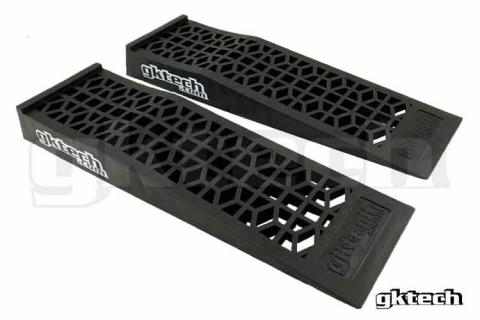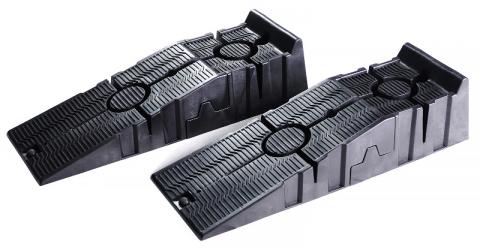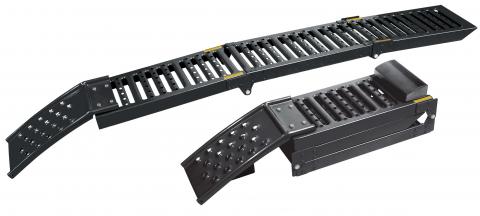About portable ramps for motor vehicles
A portable vehicle ramp has an incline and a platform that supports a motor vehicle or car during maintenance or when it's on display.
The mandatory standard applies to portable vehicle ramps that can withstand weights up to and including 1,500 kilograms. Always check the weight of your car with the manufacturer before using portable vehicle ramps.
Risks and injuries from the product
A vehicle supported by poor quality portable ramps or poorly set up ramps can fall or roll onto a person working underneath or bystanders. This can cause serious injury or death.
Things to look for when buying the product
Death and serious injuries have happened to people using portable vehicle ramps incorrectly. For this reason, there’s a mandatory standard that suppliers and retailers must comply with.
Only buy or use a ramp that complies with the portable ramps for vehicles mandatory standard.
Design and construction
- The ramp has features that prevent roll off. Each ramp must be able to stop the vehicle from rolling down its incline.
- The ramp has features that prevent over travel. Each ramp must be able to prevent the vehicle travelling forward off the platform.
Marks and labels
- Instructions for safe use, marking and assembly, as required by the mandatory standard.
- A permanent warning notice marked on the ramp.
- The maximum load capacity in kilograms marked on the ramp.
Portable vehicle ramps must be permanently marked with this warning notice:
Second-hand portable vehicle ramps
If you decide to use, buy or borrow a second-hand ramp, check that:
- it's in good condition and working order
- it complies with the mandatory standard
- instructions for safe use and assembly, if required, are provided.
For tips and more information, see Buying second-hand products that are safe.
How to use the product safely
- Read all instructions that come with the ramps. Check the load capacity and that the ramps are suitable for the width and diameter of your vehicle’s tyres.
- Use ramps on a hard level surface, preferably concrete, and always use ramps in pairs.
- If you’ve never used ramps before, be ready to stop quickly if you apply too much throttle. If you don’t get to the top of the ramp first go, let the vehicle roll back, stop at the bottom, adjust the ramps as necessary and try again.
- Anchor the ramps to prevent them from moving when a vehicle is driven onto them.
- Turn the wheels to a straight ahead position. Place the ramps against the tyres so that each ramp is in line with the respective wheel.
- Slowly drive the vehicle onto the ramp platform with guidance from a person outside the vehicle. The person providing guidance should stand in a safe place, away from the vehicle's line of travel and with an escape route.
- The guide should be on the driver’s side, one car length away from and one car width to the side of the driver. They should still be able to see the alignment of the ramps and wheels, but remain safe if the ramps move or if the vehicle slides off one or both ramps.
- Apply the parking brake and place a chock under at least one of the wheels still on the ground. This is so the vehicle cannot accidentally roll off the ramps.
- Take care when stepping out of the car when it’s at the top of the ramps as it will be much higher than when you got in.
Watch our video on DIY car repair safety
Robinette Emonson lost her husband after he was crushed by his car while working in his garage.
She shares her story to help raise awareness and share an important safety message about DIY car repairs.
Video transcript
ROBINETTE: I'm Robinette and I'm here to talk to you about garage safety and my experiences.
My late husband was a car mad man. From the time he grew up on the farm in Swan Hill, where his first car was a bush-basher. Bob's last car was a 1967 MGB Mark II. He had to make a choice of the MG or me, back when we first got married. So he finally got his MG, might have been 46 years later but...
Bob was very knowledgeable when it came to working around and under cars. He was working under his car, the car was on ramps, but the car rolled off the ramps and he was trapped underneath it. I got that dreaded phone call and the rest is history really. So from that moment, my life and the life of my children, changed dramatically.
I would hate to think that this could happen to anybody else. This is not a rarity, this happens more often than people could possibly imagine. It can happen to anybody. I'm making a plea to you, make Bob's legacy the fact that you, have taken an extra few minutes not to rush and to take your time and you've been careful. It's your life and it's the life of your family and your children and your grandchildren.
Sitting at home alone, it's awful. Nobody to talk to and I miss having a hug. Miss that a lot!
NARRATOR: Authorised by the Australian Government, Canberra.








